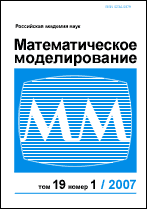|
This article is cited in 22 scientific papers (total in 22 papers)
Modeling position selection by individuals during information warfare with a two-component agenda
A. P. Petrova, O. G. Pronchevab
a Keldysh Institute of Applied Mathematics of RAS
b Moscow Institute of Physics and Technology
Abstract:
The paper develops and analyses the mathematical model of position selection by individuals during propaganda battle on two topics. A population is considered in which two parties are competing and debating on these two topics. The parties circulate their messages through affiliated mass media; individuals adopt these messages and relay them further to other individuals. According to the agenda-setting theory, the relative importance of topics is determined by their media saliency. The mathematical model is presented in two versions, namely basic and complex. The basic one implies that interpersonal communications are homogeneously distributed throughout population. The complex version assumes that the population consists of two groups (which may be imagined as ethnic groups or social classes, etc.) such that communications are more intensive within each group that between persons from different groups. For this model, a simple Blotto game is considered: each party allocates its media broadcasting resource between two topics in order to maximize the number of supporters at the end of the propaganda battle.
Keywords:
mathematical modeling, propaganda battle, agenda-setting, model of position selection by individuals.
Received: 11.03.2019
Revised: 11.03.2019
Accepted: 08.04.2019
Citation:
A. P. Petrov, O. G. Proncheva, “Modeling position selection by individuals during information warfare with a two-component agenda”, Mat. Model., 31:7 (2019), 91–108; Math. Models Comput. Simul., 12:2 (2020), 154–163
Linking options:
https://www.mathnet.ru/eng/mm4097 https://www.mathnet.ru/eng/mm/v31/i7/p91
|

| Statistics & downloads: |
| Abstract page: | 335 | | Full-text PDF : | 97 | | References: | 47 | | First page: | 7 |
|




 Contact us:
Contact us: Terms of Use
Terms of Use
 Registration to the website
Registration to the website Logotypes
Logotypes








 Citation in format
Citation in format 
